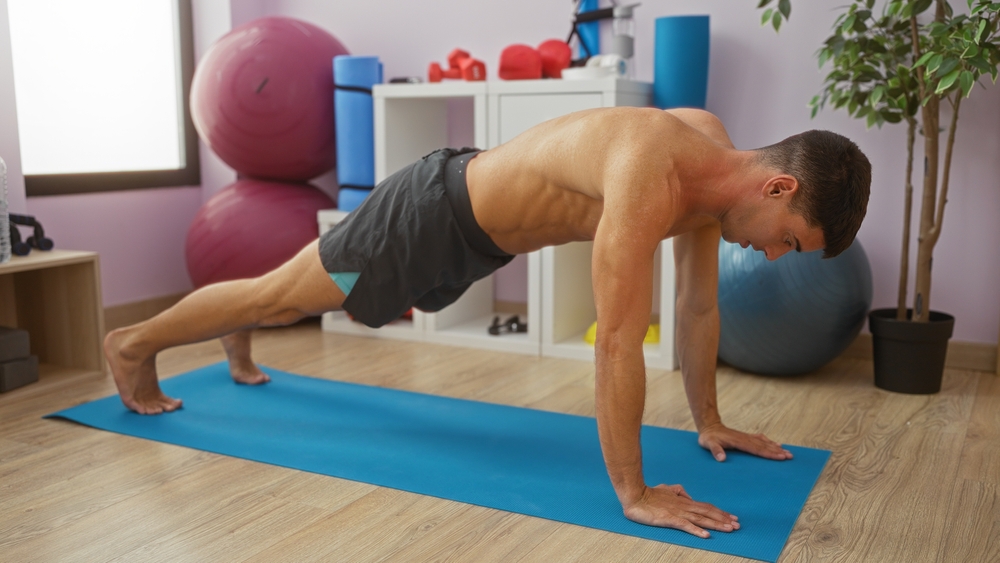The 30-day pushup challenge is a progressive strength-building program where you systematically increase your pushup capacity from your current baseline to achieving goals like 50 consecutive pushups or 100 daily reps, depending on your starting fitness level.
You'll follow a structured plan with specific daily targets, proper form requirements, and strategic rest periods to safely build upper body strength while avoiding injury.
Keep reading to discover the complete science-backed program, proper form techniques, and level-specific progressions that will transform your upper body strength in just one month.
The Science Behind Your 30-Day Pushup Transformation
Your body starts adapting to pushup training faster than you might expect.
Coordination improvements happen immediately as your nervous system learns to recruit multiple muscle groups efficiently.
Strength gains become noticeable within the first week, while visible muscle changes follow several weeks later.
What happens during each pushup:
- Your chest, shoulders, and triceps drive the primary movement
- Core muscles stabilize your entire torso
- Back muscles and smaller stabilizers maintain proper alignment
- Multiple muscle groups work together rather than in isolation
This compound movement pattern explains why pushups serve as such a reliable fitness indicator.
Research tracking over 1,000 participants for 10 years revealed that people who could complete more than 40 pushups had a 96% lower risk of cardiovascular disease compared to those managing fewer than 10.
Your pushup capacity essentially predicts your overall health and fitness level.
Realistic physical changes you can expect: Advanced practitioners documented 0.5-inch gains in both chest and tricep measurements after 30 days of consistent training.
However, these visible changes represent just one aspect of your transformation.
The more significant adaptations happen in your nervous system first.
Your brain becomes more efficient at coordinating muscle contractions, allowing you to generate more force and maintain better form.
This neural adaptation phase creates the foundation for strength improvements that continue building throughout your challenge.
Your cardiovascular system also benefits from sustained pushup training.
The continuous muscle engagement elevates your heart rate and improves blood flow, contributing to the documented heart disease risk reduction.
This dual strength and cardiovascular benefit makes pushups uniquely effective for comprehensive fitness improvement in a relatively short timeframe.
Essential Preparation: Form, Safety, and Self-Assessment
Before jumping into any challenge, you need to know where you stand.
Your baseline test determines which program level matches your current abilities and prevents you from starting too aggressively or too conservatively.
Your Baseline Assessment
Step-by-step testing protocol:
- Warm up with light arm circles and shoulder rolls
- Get into perfect pushup position
- Perform as many consecutive pushups as possible with flawless form
- Stop immediately when your form breaks down
- Record this number—it's your starting point
Your results determine your path:
- 5 or fewer pushups = Beginner level
- 6-10 pushups = Intermediate level
- 11-20 pushups = Advanced level
Non-Negotiable Form Standards
Perfect form isn't optional—it's what separates effective training from wasted effort and potential injury.
Your body should form a straight line from head to heels throughout the entire movement.
Position your hands directly under your shoulders, not wider or narrower.
Critical positioning details:
- Keep elbows at 45-degree angles from your body (not flared out to 90 degrees)
- Lower your chest all the way to the floor
- Push up to complete arm extension without locking elbows aggressively
- Maintain rigid core engagement to prevent hip sagging or rising
Your core acts as the foundation for everything else.
Engage your abdominal muscles as if someone's about to punch your stomach, then maintain that tension throughout every repetition.
This prevents the common mistake of letting your hips sag, which shifts stress to your lower back instead of targeting the intended muscles.
Injury Prevention and Recovery
Most pushup-related injuries stem from poor form or inadequate recovery.
Lower back pain typically results from hip sagging, while shoulder strain comes from improper elbow positioning.
Wrist issues develop when you place too much weight on your hands without proper alignment.
Smart recovery practices: Allow 48-72 hours between intense training sessions.
Your muscles need this time to repair and strengthen.
Training daily without adequate rest leads to overuse injuries and performance plateaus.
Watch for warning signs like persistent joint pain, sharp shooting pains, or pain that worsens rather than improves with movement.
Normal muscle soreness feels different from injury pain—learn to distinguish between them.
Modifications for Common Limitations
If you experience wrist discomfort, try pushups on your fists or invest in pushup handles that maintain neutral wrist position.
For shoulder limitations, focus on keeping elbows closer to your body and reduce your range of motion until mobility improves.
People with lower back issues should start with incline pushups against a wall or elevated surface, which reduces the load on your core while you build strength progressively.
Never push through sharp pain—modify the exercise instead.
Your Complete 30-Day Progressive Program
Each level follows a strategic four-week progression: foundation building in week one, skill development in week two, intensity increases in week three, and peak performance in week four.
Your baseline test result determines which path you follow, but you can adjust based on how your body responds.
Beginner Level (0-5 Baseline Pushups)
Your goal isn't just completing pushups—it's building the strength foundation needed for proper form.
This progression takes you from wall pushups to your first full pushups safely and systematically.
Week 1: Foundation Building Training schedule: Monday, Wednesday, Friday
- Wall pushups: 3 sets of 8-12 reps
- Plank holds: 2 sets of 30 seconds
- Pushup negatives: 3 sets of 5 reps (lower slowly, reset on knees)
Week 2: Incline Progression
- Incline pushups (couch or stairs): 3 sets of 6-10 reps
- Knee pushups: 2 sets of 5-8 reps
- Plank holds: 2 sets of 45 seconds
Week 3: Mixed Training
- Knee pushups: 3 sets of 8-12 reps
- Scapular pushups: 2 sets of 10 reps
- Incline pushups: 2 sets of 12-15 reps
Week 4: Full Pushup Introduction
- Full pushups: 1-3 reps (as many as possible with perfect form)
- Knee pushups: Complete remaining reps to reach 15-20 total
- Target: 25 consecutive pushups by month end (any variation)
Intermediate Level (6-20 Baseline Pushups)
You're building volume and introducing variations while working toward the milestone of 50 consecutive pushups.
This level balances progression with recovery to prevent overuse injuries.
Week 1: Volume Foundation Every other day training:
- Basic pushups: 4 sets with 60-second rest between sets
- Target daily total: 25-30 pushups
- Focus entirely on maintaining perfect form
Week 2: Variation Integration
- Standard pushups: 3 sets
- Wide-grip pushups: 2 sets
- Diamond pushups: 1 set
- Target daily total: 35-40 pushups
Week 3: Intensity Increase
- Mixed variations targeting different muscle groups
- Reduce rest periods to 45 seconds
- Target daily total: 45-50 pushups
Week 4: Peak Performance Primary goal: Complete 50 pushups in a single unbroken set.
Alternative approach: 4 sets of 15-20 with only 30-second rest between sets.
Advanced Level (20+ Baseline Pushups)
Your program uses progressive overload principles with varied difficulty levels throughout each workout.
The structure prevents adaptation while building toward advanced movement patterns.
Daily Format (100 pushup structure):
- 12 reps medium progression (variation you can do ~15 reps maximum)
- 4 sets × 6 reps hard progression (60-second rest between sets)
- 4 sets × 16 reps easy progression (performed with speed)
- Remaining reps: Mix of standard and challenging variations
Advanced progression examples:
- Decline pushups with feet elevated
- Single-arm progression exercises
- Wall handstand pushups
- Plyometric or clapping pushups
- Extended range-of-motion pushups
Scheduling and Recovery Options
Three-day weekly schedule: Monday, Wednesday, Friday training with full rest days between sessions. This approach maximizes recovery and allows for higher intensity during training days.
Every other day schedule: More flexible timing while maintaining the critical 48-72 hour recovery window between sessions.
Daily structure flexibility: You can complete all reps in one focused session or break them into multiple sets throughout the day. For instance, if your goal is 100 pushups, you might do 10 sets of 10 spread across morning, afternoon, and evening.
Progression Adjustments
Monitor your body's response and adjust accordingly.
If you're consistently exceeding your target numbers with good form, advance to more challenging variations.
If you're struggling to hit targets or experiencing excessive fatigue, scale back the intensity or add extra rest days.
The key indicator for progression readiness is maintaining perfect form throughout your sets.
Quality always trumps quantity in building sustainable strength improvements.
Advanced Variations and Performance Optimization

Once you master basic pushups, your progression depends on strategic variation and intelligent recovery.
The goal shifts from simply doing more reps to mastering increasingly challenging movement patterns that continue building strength.
The Complete Difficulty Spectrum
Progressive difficulty ladder (easiest to hardest):
- Wall pushups
- Incline pushups (various heights)
- Knee pushups
- Standard pushups
- Wide-grip and diamond pushups
- Decline pushups
- Single-leg pushups
- Fingertip pushups
- One-arm progressions
- Handstand pushups
This spectrum gives you precise control over difficulty.
When standard pushups become too easy (you can do 30+ reps), progress to the next level rather than endlessly increasing repetitions.
Strategic Variation Rotation
Rotate between different pushup types daily to prevent your muscles from adapting to a single pattern.
This approach targets different muscle groups while maintaining engagement throughout your 30-day challenge.
Daily rotation example:
- Monday: Standard and wide-grip focus
- Wednesday: Diamond and decline emphasis
- Friday: Single-leg and plyometric work
Each variation shifts the primary stress to different muscles.
Wide-grip pushups emphasize your chest, while diamond pushups target triceps more intensively.
Decline pushups with feet elevated increase the load on your shoulders and upper chest.
Advanced Movement Patterns
Plyometric pushups develop explosive power by requiring you to push off the ground with enough force to lift your hands.
Start with small “pops” off the ground before progressing to clapping pushups.
Single-arm progressions begin with elevated single-arm pushups (hand on bench) before advancing to floor-level attempts.
This variation dramatically increases core stability demands while building unilateral strength.
Extended range-of-motion pushups use pushup handles or books under your hands to lower your chest below hand level.
This increases the stretch on your chest muscles and builds strength through a greater range of motion.
Recovery and Performance Optimization
Structured rest protocols: Monitor your body's fatigue signals rather than blindly following a schedule.
Persistent muscle soreness, declining performance, or joint stiffness indicate you need additional recovery time.
Between sets, rest 60-90 seconds for strength-focused training or 30-45 seconds when building endurance.
These intervals allow partial recovery while maintaining training stimulus.
Performance scheduling considerations: Morning sessions can energize your entire day and ensure you complete your workout before other commitments interfere.
Evening sessions help release accumulated stress and tension from your day.
However, avoid intense training within 3 hours of bedtime, as the elevated heart rate and adrenaline can interfere with sleep quality.
Warm-Up and Equipment Considerations
Even bodyweight exercises require preparation.
Spend 5 minutes on arm circles, shoulder rolls, and light movement to increase blood flow and joint mobility before training.
Equipment modifications for comfort:
- Pushup handles maintain neutral wrist position and allow deeper range of motion
- Fist pushups eliminate wrist extension if you experience discomfort
- Yoga mats provide cushioning for outdoor training surfaces
These tools aren't necessary but can enhance comfort and allow you to focus on the movement rather than managing discomfort.
The key is maintaining consistency regardless of your setup—bodyweight training's beauty lies in its simplicity and accessibility.
Overcoming Common Challenges and Plateaus
The biggest obstacle in any 30-day challenge isn't physical—it's mental.
Your body will adapt faster than your mind accepts the discomfort, but recognizing common pitfalls helps you navigate them before they derail your progress.
Quality Over Quantity: The Form Trap
The moment you start prioritizing numbers over technique, your challenge becomes counterproductive.
Form deterioration happens gradually, making it easy to miss until you're essentially doing a different exercise.
Warning signs of declining form:
- Hips sagging or rising above shoulder level
- Elbows flaring out beyond 45 degrees
- Partial range of motion (not touching chest to floor)
- Holding breath instead of controlled breathing
- Speed increases at the expense of control
When you notice form breaking down, stop immediately.
Rest for 30-60 seconds, then continue with perfect technique, even if that means fewer total reps.
Your strength gains come from challenging your muscles correctly, not from accumulating sloppy repetitions.
The Variation Selection Sweet Spot
Most people choose variations that are either too easy or impossibly difficult.
If you can perform more than 30 reps of any variation, it's too easy and won't stimulate strength improvements.
Conversely, if you can't complete at least 5 reps with perfect form, the variation is too advanced.
Target range for effective training:
- Strength building: 5-12 reps per set
- Endurance building: 15-25 reps per set
- Never exceed: 30 reps of the same variation
When standard pushups become too easy, progress to decline pushups or diamond pushups rather than doing endless repetitions.
This progression principle keeps your muscles adapting throughout the entire 30 days.
Breaking Through Plateaus
Plateaus typically result from three factors: insufficient progression, inadequate recovery, or poor nutrition support.
Your body adapts to training stress within 7-10 days, so you must continuously challenge it with new stimuli.
Plateau-breaking strategies:
- Insufficient progression fix: Advance to a more challenging variation or increase daily volume by 10-15%
- Recovery optimization: Add an extra rest day or reduce training intensity for one week
- Nutrition support: Ensure adequate protein intake (0.8-1g per pound of body weight) for muscle recovery
Sometimes plateaus indicate your body needs a brief recovery period rather than more intensity.
Listen to your energy levels and performance quality rather than forcing through fatigue.
Recognizing Injury vs. Normal Discomfort
Normal muscle fatigue characteristics:
- Gradually building soreness that peaks 24-48 hours after training
- Symmetrical discomfort in both sides of your body
- Improves with gentle movement and warming up
- Doesn't worsen with continued activity
Injury warning signs:
- Sharp, shooting pains during or immediately after exercise
- Asymmetrical pain affecting only one side
- Pain that worsens with movement or persists beyond 72 hours
- Joint pain rather than muscle soreness
Stop training immediately if you experience injury symptoms.
Most pushup-related injuries respond well to 3-5 days of complete rest, but persistent issues require professional evaluation.
Maintaining Motivation Throughout 30 Days
Week-by-week motivation challenges:
- Week 1: Initial enthusiasm carries you through
- Week 2: Novelty wears off, routine feels difficult
- Week 3: Progress slows, questioning if it's working
- Week 4: Final push requires mental toughness
Combat motivation dips by tracking multiple metrics beyond just repetition count.
Notice improvements in form quality, reduced fatigue between sets, or increased ease with daily activities.
These indicators often improve before dramatic strength gains become apparent.
Create accountability through progress photos, workout logs, or training partners.
External motivation helps bridge the gaps when internal drive wavers.
Smart Progression Adjustments
Your daily performance will fluctuate based on sleep quality, stress levels, and recovery status.
Rigid adherence to a predetermined schedule ignores these natural variations and can lead to overuse injuries.
Daily adjustment guidelines:
- Feeling strong and energetic: Add 10-20% more reps or try a harder variation
- Feeling fatigued but not injured: Reduce intensity by 20% but maintain consistency
- Experiencing unusual soreness: Take an unplanned rest day
- Recovering from missed days: Resume at previous level, don't try to “catch up”
Successful completion depends more on consistency than perfection.
Missing one or two days won't derail your progress if you maintain your routine afterward.
Performance Monitoring Beyond Rep Count
Track improvements across multiple dimensions to get a complete picture of your progress.
Strength gains often manifest in ways that aren't immediately obvious through repetition counting alone.
Comprehensive progress indicators:
- Form quality improvements (deeper range of motion, better alignment)
- Recovery speed between sets
- Ease of daily activities requiring upper body strength
- Confidence in attempting new variations
- Overall energy levels and exercise enjoyment
This holistic approach helps you recognize success even during periods when numerical progress seems to stall, maintaining motivation throughout your entire 30-day journey.
Maximizing Long-Term Results and Integration
The real value of your 30-day pushup challenge extends far beyond the final day.
You've built a foundation of consistent exercise habits and upper body strength that becomes the launching point for comprehensive fitness development.
Post-Challenge Progression Strategy
Your body will need increased challenges to continue growing after 30 days of adaptation.
Simply repeating the same program won't produce additional gains—you need a clear progression path that builds on your achievements.
Immediate post-challenge options:
- Advance to more complex pushup variations (handstand progressions, archer pushups)
- Increase training frequency to 4-5 days per week with varied intensities
- Integrate weighted pushups using a backpack or weighted vest
- Transition to advanced calisthenics movements like muscle-ups or human flags
The key principle remains progressive overload.
Continue challenging your muscles with variations they haven't adapted to, whether through increased difficulty, volume, or training frequency.
Creating Exercise Balance
Pushups primarily target pushing muscles—chest, shoulders, and triceps.
Without balancing exercises, you'll develop muscle imbalances that affect posture and increase injury risk over time.
Essential pulling movements to incorporate:
- Pull-ups or assisted pull-ups for back and biceps
- Inverted rows using a table or TRX system
- Band pull-aparts for rear deltoids
- Face pulls targeting posterior shoulder muscles
Aim for a 1:1 ratio between pushing and pulling exercises.
If you perform 100 pushups, balance with equivalent pulling volume through combinations of the above movements.
Building Sustainable Habits
Your 30-day challenge established the most valuable fitness asset: consistency.
This habit foundation transfers to other areas of health and performance when you leverage it strategically.
Habit expansion techniques: Start small by adding one new movement pattern every two weeks.
You might introduce bodyweight squats during week 1, then add pulling exercises during week 3.
This gradual expansion prevents overwhelming your schedule while building comprehensive fitness.
The morning routine you established can accommodate additional exercises without disrupting your day.
Five minutes of pushups easily expands to 10-15 minutes incorporating multiple movement patterns.
Comprehensive Fitness Integration
Lower body integration: Add squats, lunges, and single-leg movements to create full-body strength development.
These exercises complement your upper body gains while improving functional movement patterns for daily activities.
Cardiovascular training synergy: Use pushups as part of circuit training or high-intensity interval workouts.
Combining pushups with jumping jacks, burpees, or mountain climbers creates cardiovascular benefits while maintaining strength focus.
Flexibility and mobility: Incorporate stretching sequences targeting chest, shoulders, and hip flexors—areas that often tighten from pushup training.
This prevents movement restrictions that could limit your progression.
Long-Term Programming Structure
Weekly template for sustained progress:
- 2-3 days: Upper body strength (pushup progressions + pulling)
- 2-3 days: Lower body and core training
- 1-2 days: Cardiovascular or active recovery
- Daily: 5-10 minutes of mobility work
This structure maintains your pushup gains while developing complete fitness.
You can adjust intensity and volume based on your goals, available time, and recovery capacity.
Professional Guidance Considerations
Seek expert advice when:
- You experience persistent pain or recurring injuries
- Progress stalls for more than 4-6 weeks despite program adjustments
- You want to pursue advanced calisthenics or specific performance goals
- You need help designing a comprehensive training program
Personal trainers specializing in bodyweight training can accelerate your progression beyond what's possible through trial and error.
They provide technique refinement, program periodization, and accountability that maximizes your time investment.
Physical therapists become valuable if you develop movement restrictions or imbalances.
Early intervention prevents minor issues from becoming major limitations.
The Compound Effect
Your 30-day pushup challenge created momentum that extends into every aspect of health and fitness.
The discipline you developed, the confidence from achieving goals, and the physical strength you built become catalysts for broader life improvements.
Use this foundation wisely.
The habits and mindset you've established during these 30 days can transform your relationship with exercise from a temporary challenge into a sustainable lifestyle that continues delivering benefits for years to come.
Conclusion
Your 30-day pushup challenge has given you more than just stronger arms and chest—you've built the foundation for lifelong fitness habits and proven you can commit to meaningful goals.
The strength gains and movement patterns you've developed will continue serving you as you expand into more complex exercises and comprehensive training programs.
Take the momentum you've created and use it to tackle your next fitness challenge, knowing you have the tools and discipline to succeed.







